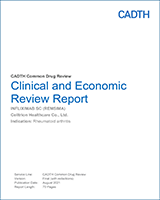Disease Background
The chronic autoimmune disorder RA is characterized by the potential for severe destructive inflammation of the joints, particularly those in the hands. The inflammation breaks down cartilage and bone, resulting in severe pain, stiffness, deformities, and disability. The inflammation can affect other areas as well, including eyes, lungs, heart, or skin. RA can strike at any age, but it is more commonly seen in adulthood. According to a 2011 report by the Arthritis Alliance of Canada, approximately 0.9% of the Canadian population has RA.1
Standards of Therapy
Treatment of RA consists both of acute therapies that address intense flares of the disease and of chronic therapies that aim at the underlying disease process itself, the DMARDs. The cDMARDs consist of small molecules that address various pathways involved in inflammatory/immune processes. They include a diverse array of drugs such as antimalarials, sulfasalazine, leflunomide, and MTX. Gold as therapy is no longer initiated, and immune suppressants such as azathioprine and cyclosporine are not highly effective and can be highly toxic. More recently, cDMARDs have been joined by the biologics (bDMARDs), a group of drugs with a shared design, being either monoclonal antibodies or fusion proteins. Inhibitors of TNF alpha are the original biologics, but they have since been joined by drugs that target interleukins (IL-1, IL-6); drugs that stimulate T cells and/or deplete B cells; and recently, the JAK inhibitors. Typically, patients will be started on 1 or more cDMARDs, most commonly MTX, and if the disease progresses, clinicians will work up to the use of biologics. Common limitations of those approaches are increased risk of infection and possibly an increased risk of certain cancers — although those risks are considered rare.2
Drug
Infliximab is a chimeric monoclonal antibody against TNF alpha, a proinflammatory cytokine and key mediator of inflammation in conditions such as RA, CD, UC, psoriatic arthritis, spondylitis, and plaque psoriasis. Infliximab induces T-cell apoptosis; reduces infiltration of inflammatory cells into inflamed joints; and lowers the expression of molecules mediating cellular adhesion, chemoattraction, and tissue degradation.3
The SC form of biosimilar infliximab (referred to as CT-P13 SC in the sponsor-completed sections of this review report) is a new formulation to be used for SC injection (120 mg/mL) in a 1 mL pre-filled syringe.
The IV formulation of biosimilar infliximab received a Health Canada NOC as Inflectra in 2014 and has been reimbursed across Canada since then. In CADTH, on December 19, 2014, infliximab IV (Inflectra) was recommended to be reimbursed for the indications of ankylosing spondylitis, plaque psoriasis, psoriatic arthritis, and RA; by October 25, 2016, it was recommended to be reimbursed for patients with CD, fistulizing CD, and UC.
Currently, infliximab is available only for IV administration (Remicade [brand], Inflectra, Renflexis, Avsola [biosimilars]); Remsima will be the first SC formulation of infliximab.
This submission is a “new formulation of existing drug” type, sent by the sponsor (Celltrion Healthcare Co., Ltd.) with a NOC status completed on January 28, 2021. The sponsor states that Remsima SC will provide patients with a format of infliximab that can easily be self-administered at home, which is particularly beneficial in the current pandemic environment. presents the indications for and characteristics of Remsima (infliximab).
Key Characteristics of Infliximab SC.

